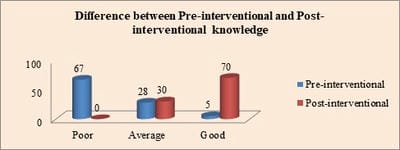“A pre-experimental study to assess the effect of educational package on knowledge regarding haematopoietic stem cell transplantation among staff nurses working in selected hospital Bhopal, Madhya Pradesh”
Singh T.1, Pakhide V.2, Verma M.3*
DOI: https://doi.org/10.17511/ijmrr.2021.i02.01
1 Tripti Singh, M Sc. Nursing, CHO, Sehore, Madhya Pradesh, India.
2 Vandana Pakhide, Assistant Professor, Pragyan College of Nursing, Bhopal, Madhya Pradesh, India.
3* Mamta Verma, Associate professor, College of Nursing, AIIMS, Bhopal, Madhya Pradesh, India.
Haematopoietic stem cell transplantation is a greater positive impact on the treatment of life-threatening diseases. Stem cell transplantation is a lifesaving procedure for several malignant and nonmalignant life-threatening diseases, more than 40,000 stem cell transplantations are being performed annually worldwide. Methods: pre-experimental, one group pre-test post-test research design was used for conducting a study in a selected hospital of Bhopal, Madhya Pradesh. Subjects comprising of 60 staff nurses selected by non-probability purposive sampling technique, who fulfilled inclusion criteria. Results: Mean post-interventional knowledge (27.0 ± 6.03) is higher than the mean pre-interventional knowledge (15.5 ± 5.74). The mean difference between pre- interventional knowledge and post-interventional knowledge is 11.5. The computed ‘t’ value 15.80, 2.00, P<0.05 shows that there is a significant difference between pre-interventional knowledge and post-interventional knowledge. There was a significant association found of demographic variables in terms of working area and years of clinical experience. Conclusion: it was concluded that the educational package was effective in enhancing the knowledge of the staff nurses. The health care professional including staff nurses also having inadequate knowledge of stem cell therapy. The skilled educative session is one of the cost-effective intervention used for educating the nurses in various aspects.
Keywords: Haematopoietic stem cell transplantation, Malignant and non-malignant disorders, Educational package.
| Corresponding Author | How to Cite this Article | To Browse |
|---|---|---|
| , Associate professor, College of Nursing, AIIMS, Bhopal, Madhya Pradesh, India. Email: |
Singh T, Pakhide V, Verma M. “A pre-experimental study to assess the effect of educational package on knowledge regarding haematopoietic stem cell transplantation among staff nurses working in selected hospital Bhopal, Madhya Pradesh”. Int J Med Res Rev. 2021;9(2):58-65. Available From https://ijmrr.medresearch.in/index.php/ijmrr/article/view/1270 |


 ©
© 